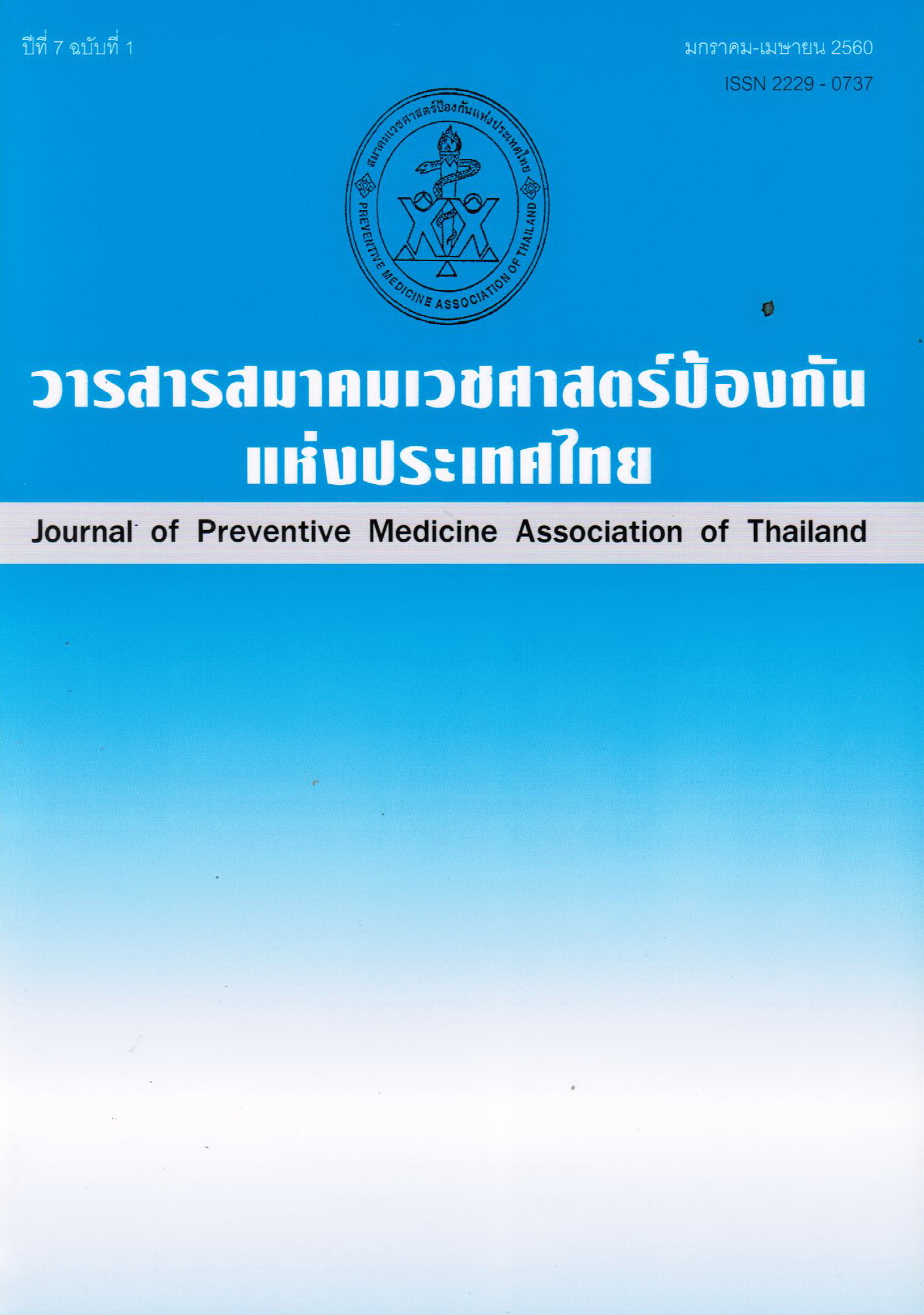Study on Infectious Waste Management Cost Analysis
Keywords:
Cost, Infection WasteAbstract
The objective of this descriptive retrospective study is to study cost management of infectious waste of Ministry of Health Hospitals. Sample in this study consisted of four public health officers or management officers who were responsible for waste management from 2 general hospitals, Prathumthani Hosiptal and Pranangklao Hospital; 2 community hospitals, Bang Bua Thong Hospital and Sampran Hospital; and 1 private hospital, Pitsanuvaj Hospital with the disposal of infectious waste collected and disseminated to other agencies removal. The sample hospitals were hospitals which had effective environmental management, sanitary, and collaborative in every department from the executive to operator of infectious waste. There is a waste management model with a way to send off to other disposal agency. The cost of the overall management of infectious waste included material and labor cost, capital cost and cost per unit cost of labor to the material on the investment. Then this cost was used to compare with the cost per unit of the general hospitals and community hospital. Infection waste management cost analysis indicated that hospital’s average amount of waste in the hospital was 9.47 kg/bed/day. 8.14 kg/bed/day, 85.94% and 1.33 kg/bed/day, respectively, 14.06%, respectively. The total cost of hospital waste management in the fiscal year 2016 was 3,762,940.24 baht. This total cost consisted of labor cost 1,248,190.00 baht, 33.38% cost of materials 2,150,000.24 baht, 57.24% and investment cost 364,750.00 baht, 9.39%. The cost
per unit (Baht/kg) was 28.15 baht/kg, consisted of labor cost, material cost, and investment cost was 10.51, 13.93, and 3.71 baht/kg, respectively, with a ratio of 2.83:3.75:1. The lowest is labor cost and lowest investment cost. This is because material costs are eliminated from other agencies.
The study found that management of solid waste will be effective, if hospitals have policy formulation, action plan, budget allocation, appointment of board oragency who will be responsible for determining the process of storing and separating solid waste. Also, compliance with the standard guidelines of the Department of Health has determined that solid waste must be strictly separated at source. Finally, effective waste management requires cooperation
between the management and workers in hospital solid waste management and the person causing the infection in the workplace.
It was found that general hospitals are more cost effective when compared to community hospitals, which had average cost of infection management 2.23 times higher than the general hospital. Community hospitals should find out the reasons for high cost of waste management and reduce the cost of disposal, and optimize the waste management process which does not pollute the public. They should find the right disposal process and also take into account
the safety of public service recipients, and staff at the hospitals. Therefore, transferring to other agencies to eliminate waste is an alternative which follows Health Act that requires local authorities to eliminate such waste.
The results of this study can be used when planning the most cost-effective and cost-effective contingency plans for managing solid waste.
References
2. กระทรวงทรัพยากรธรรมชาติและสิ่งแวดล้อม กรมควบคุมมลพิษ. การจัดการขยะมูลฝอยชุมชนอย่างครบวงจร คู่มือสำหรับผู้บริหารองค์กรปกครองส่วนท้องถิ่น. พิมพ์ครั้งที่ 4. กรุงเทพฯ: โรงพิมพ์คุรุสภาลาดพร้าว, 2557.
3. สุคนธ์ เจียสกุล และคณะ. การจัดการมูลฝอยติดเชื้อ: สถานการณ์และระบบการบริหารจัดการที่เหมาะสมสำหรับประเทศไทย. นนทบุรี: สำนักวิชาการกรมอนามัย กระทรวงสาธารณสุข. 2545.
4. สมยศ ศรีจารนัย. (ร่าง) กรอบทิศทางแผนพัฒนาสุขภาพแห่งชาติในช่วงแผนพัฒนาเศรษฐกิจและสังคมแห่งชาติ ฉบับที่ 12 (พ.ศ. 2560-2564). (เข้าถึงเมื่อ 18 กรกฎาคม 2559. เข้าถึงได้จาก: http://www.pho.in.th/index.php/yuth/itemlist/category/170-plan2015
5. ส่วนสิ่งแวดล้อม สำนักงานทรัพยากรธรรมชาติและสิ่งแวดล้อมจังหวัดอุทัยธานี. คู่มือองค์ความรู้การบริหารจัดการขยะมูลฝอย ปีงบประมาณ 2555. (เข้าถึงเมื่อ 18 กรกฎาคม 2559. เข้าถึงได้จาก: http://www.uthaithani.go.th/MainMenu/km/KM55/knowlage1.pdf
6. บุปผา ลีฉลาด. ต้นทุนการกำจัดมูลฝอยติดเชื้อระหว่างโรงพยาบาลดำเนินการเองกับการจ้างเหมาภายนอก: กรณีศึกษาโรงพยาบาลบึงสามพัน จังหวัดเพชรบูรณ์. เอกสารประกอบการประชุมวิชาการระดับชาติมหาวิทยาลัยศรีปทุม ประจำปี 2554; 21 ตุลาคม 2554; ณ มหาวิทยาลัยศรีปทุม. กรุงเทพฯ: มหาวิทยาลัยศรีปทุม; 2554: หน้า 622-3.
7. วัชราภรณ์ ผลพูล, อรรถกร เก่งพล, สมรัฐ เกิดสุวรรณ. การศึกษาระบบการกำจัดมูลฝอยติดเชื้อที่เหมาะสมสำหรับโรงพยาบาลตัวอย่าง. วารสารวิชาการพระจอมเกล้าพระนครเหนือ 2549;2:49-56.
Downloads
Published
How to Cite
Issue
Section
License
บทความที่ลงพิมพ์ในวารสารเวชศาสตร์ป้องกันแห่งประเทศไทย ถือเป็นผลงานวิชาการ งานวิจัย วิเคราะห์ วิจารณ์ เป็นความเห็นส่วนตัวของผู้นิพนธ์ กองบรรณาธิการไม่จำเป็นต้องเห็นด้วยเสมอไปและผู้นิพนธ์จะต้องรับผิดชอบต่อบทความของตนเอง





